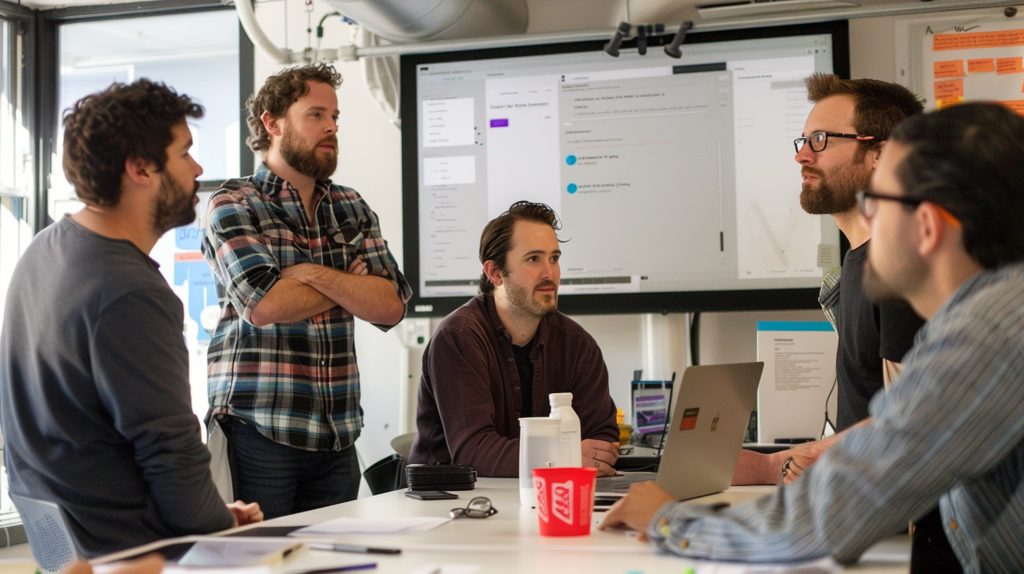Agile product development: Why flexibility is key to success
Markets are constantly evolving and customer preferences shift rapidly. This is why businesses need a method that keeps them adaptable. Enter agile product development - a proven approach that prioritises flexibility, collaboration, and iterative progress.

Agile product development is particularly valuable for startups and businesses striving for innovation, as it enables them to adapt to changes swiftly and efficiently. Let’s dive deeper into why flexibility is the cornerstone of agile product development, its benefits, when to use it, and at the end – find great tips for leveraging it effectively.
What Is Agile Product Development?
Agile product development is a methodology that emphasises iterative progress, collaboration among cross-functional teams, and adaptability to changing requirements. Unlike traditional methods such as Waterfall, which rely on linear project timelines, Agile breaks development into smaller, manageable increments known as sprints. Each sprint delivers a potentially shippable product increment, ensuring continuous delivery and improvement.
The benefits of Agile Product Development
Enhanced flexibility
Agile thrives on adaptability. It allows teams to pivot and respond to customer feedback, market changes, or challenges without the danger to ruin the entire project.
Faster time-to-market
By focusing on incremental deliveries, Agile enables teams to release functional products faster. Startups, in particular, benefit from this as they can quickly test ideas in the market.
Improved collaboration
Agile encourages collaboration between developers, designers, stakeholders, and clients. Regular communication fosters transparency and ensures everyone is familiar with goals.
Higher customer satisfaction
Agile puts customers at the centre of the development process. By continuously incorporating feedback, teams can deliver products that truly meet user needs and expectations while solving the main pain points.
Risk mitigation
Dividing work into sprints reduces the risk of complete project failure. Teams can identify and address issues early in the process, preventing costly mistakes.
Quality assurance
Continuous testing and iterative feedback loops ensure that the product meets high-quality standards at every stage of product development life cycle.
Budget control
Agile allows businesses to better manage budgets. Since progress is reviewed at the end of each sprint, teams can make informed decisions about resource allocation (which is particularly important for startups).
When to use the agile method
Agile isn’t a one-size-fits-all solution. While it can be used for many different projects, it’s most effective in certain scenarios.
Unclear or evolving requirements
If your project requirements are likely to change or evolve, Agile provides the flexibility to adapt without significant disruptions.
Startups and innovative projects
For startups or projects involving cutting-edge technology, Agile’s iterative nature reduces the risk of launching an untested product.
Time-sensitive projects
When speed is essential, Agile’s focus on delivering functional increments ensures faster progress compared to traditional methods.
Cross-functional teams
If your project involves collaboration across different departments, Agile facilitates communication and cooperation seamlessly.

Tips for making the most out of Agile
Agile development, while powerful, requires thoughtful implementation. If you are looking to find top tips for maximising its potential, here is what our 10+ years of experience has taught us.
1. Build a strong team
Agile depends on cohesive, cross-functional teams. Ensure your team includes individuals with diverse skills who can collaborate effectively. The easiest way to find such a team is to hire companies that offer IT nearshoring services. In this way you can scale your team according to your business needs.
2. Break down work effectively
The best part of working with Agile is the ability to divide the project into smaller tasks or user stories. They can be thus completed within a sprint, which keeps the team focused and ensures measurable progress.
3. Set clear goals for each sprint
A well-defined sprint goal provides direction and helps the team stay aligned. Use SMART (Specific, Measurable, Achievable, Relevant, Time-bound) goals for clarity. In this way everyone will be on the same page at all times.
4. Foster transparent communication
Hold regular meetings such as daily stand-ups, sprint reviews, and retrospectives. These foster transparency, identify roadblocks early, and encourage continuous improvement. Also, you will know exactly what your team is working on, so it is easy to follow progress.
5. Invest in Agile tools
Leverage project management tools like Jira, Trello, or Asana to streamline workflow, track progress, and facilitate collaboration among team members. Some of them are even free to use for a number of users, so take advantage of exploring them before incorporating one in your project.
6. Start with a Minimum Viable Product (MVP)
For startups, launching an MVP allows you to test the waters before fully committing resources. Agile’s iterative nature makes it perfect for refining MVPs based on user feedback. As a startup owner, you will get a great way to test your idea and make any necessary changes early on.
7. Be open to change
Flexibility is at the heart of Agile. Don’t be afraid to pivot if new data or feedback suggests a better path. Look at it as a learning process to create the best possible product for your target audience.
Why startups thrive with Agile
For startups, agility isn’t just an advantage – it’s a necessity. Limited resources, rapidly changing markets, and the need to outpace competitors make Agile a perfect fit. Its iterative approach ensures startups can test, learn, and adapt quickly without overcommitting to a single idea.
Agile also supports innovation. Startups often work on groundbreaking ideas, and Agile allows for experimentation and risk-taking while minimising potential losses. By maintaining close collaboration with customers, startups can fine-tune their offerings to meet market demands effectively.
Conclusion
Agile product development has revolutionised the way businesses approach projects. Its flexibility ensures that teams can adapt to change, prioritise customer satisfaction, and deliver high-quality products efficiently. For startups, Agile is a game-changer, enabling them to test ideas, manage risks, and stay ahead in competitive markets.
At Holycode, we specialise in helping businesses unlock their full potential. If you’re ready to embrace the power of Agile and take your product to the next level, get in touch with our team today.
Let’s build something amazing together – one sprint at a time.
Let’s start achieving excellence together
Get in touch with our experts today to turn your ideas into reality and accelerate business growth.




